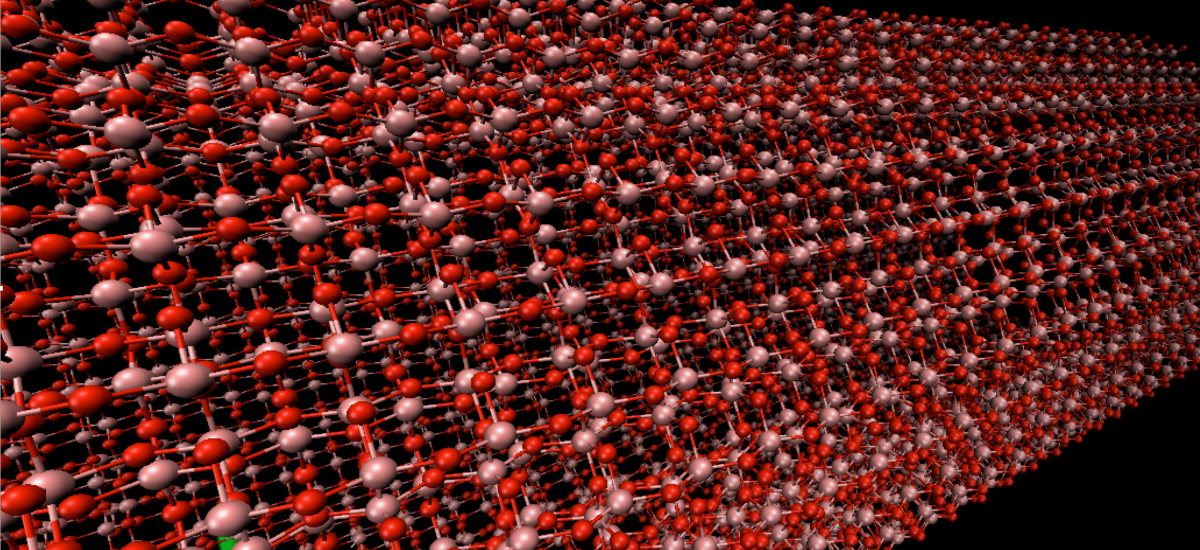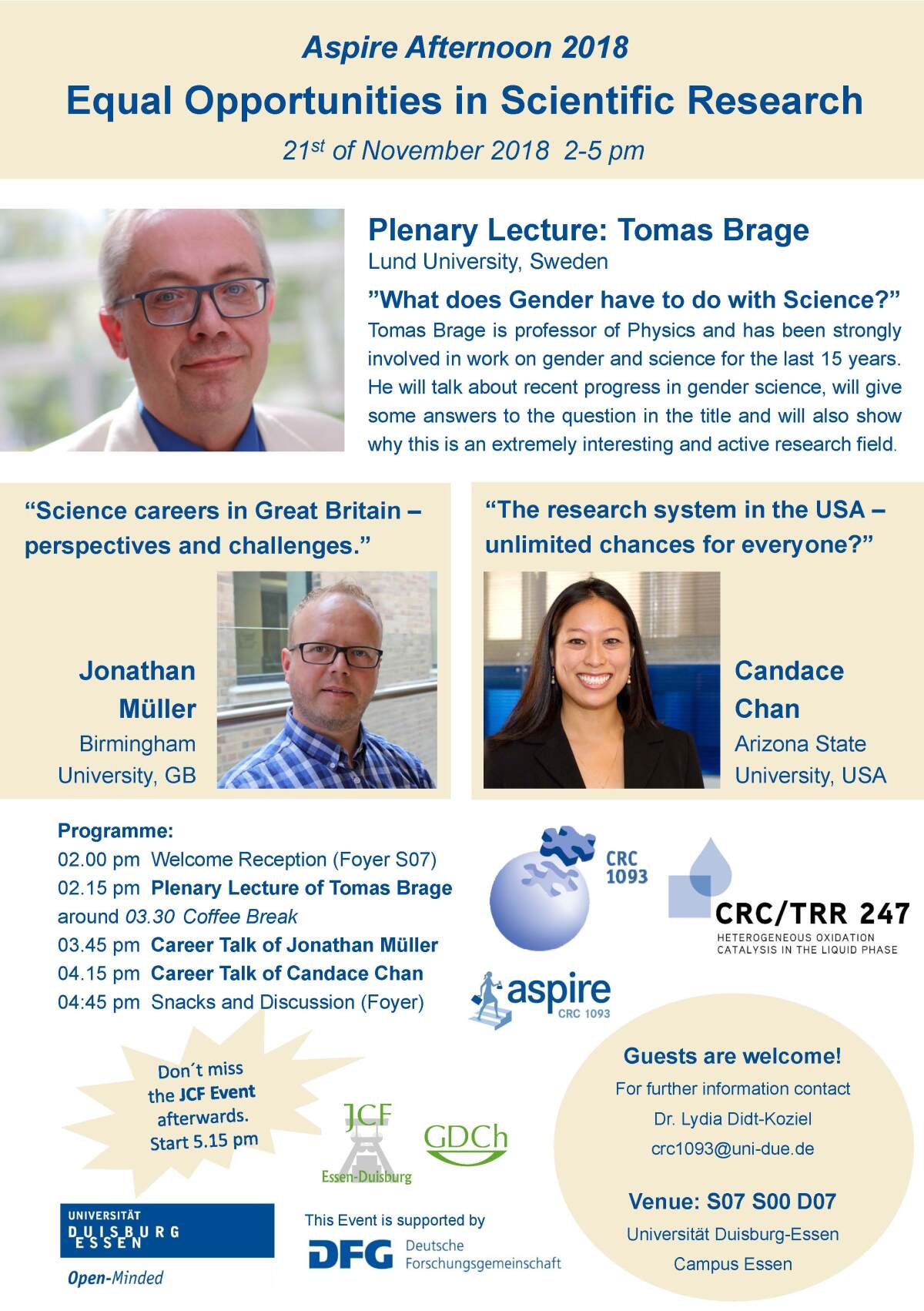News 2018
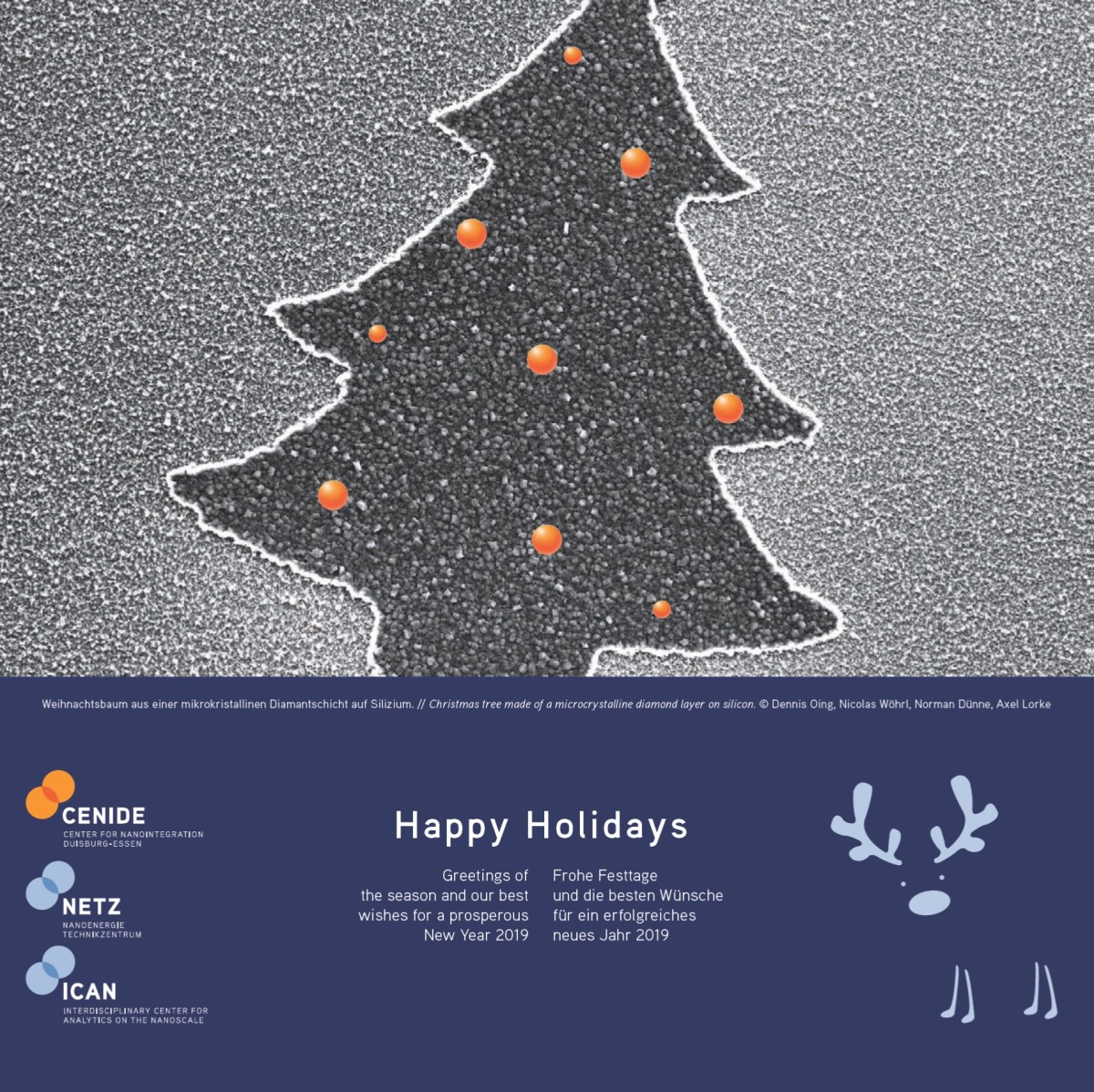
Happy HolidaysChristmas greetings
Greetings of the season and our best wishes for a prosperous New Year 2019!
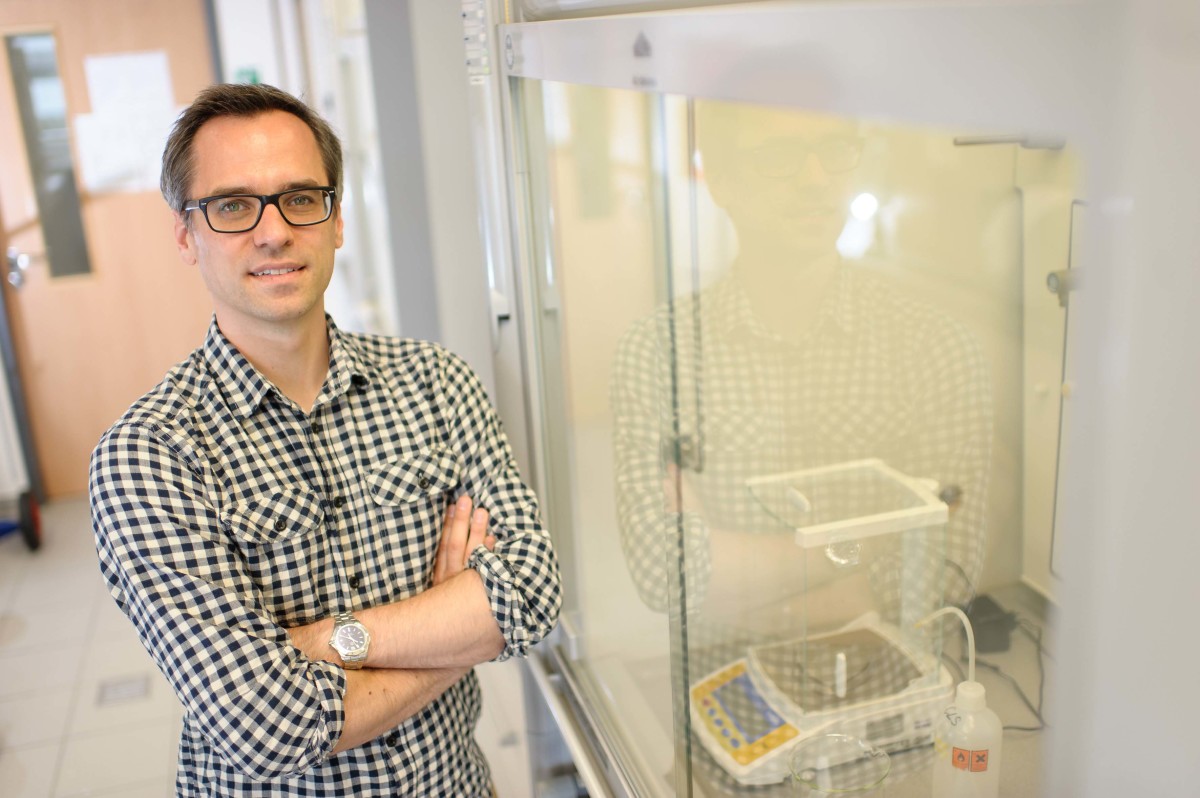
UA RuhrJoint platform for catalysis research
Prof. Dr. Malte Behrens will continue his work in teaching and research with a UA Ruhr professorship in "Materials Chemistry of Catalysts" at the faculty of chemistry, University Duisburg-Essen and at the faculty of chemistry and biochemistry, Ruhr-University Bochum.
> more about: Press release idw, 14.12.2018
> more about: Press release CENIDE, 17.12.2018
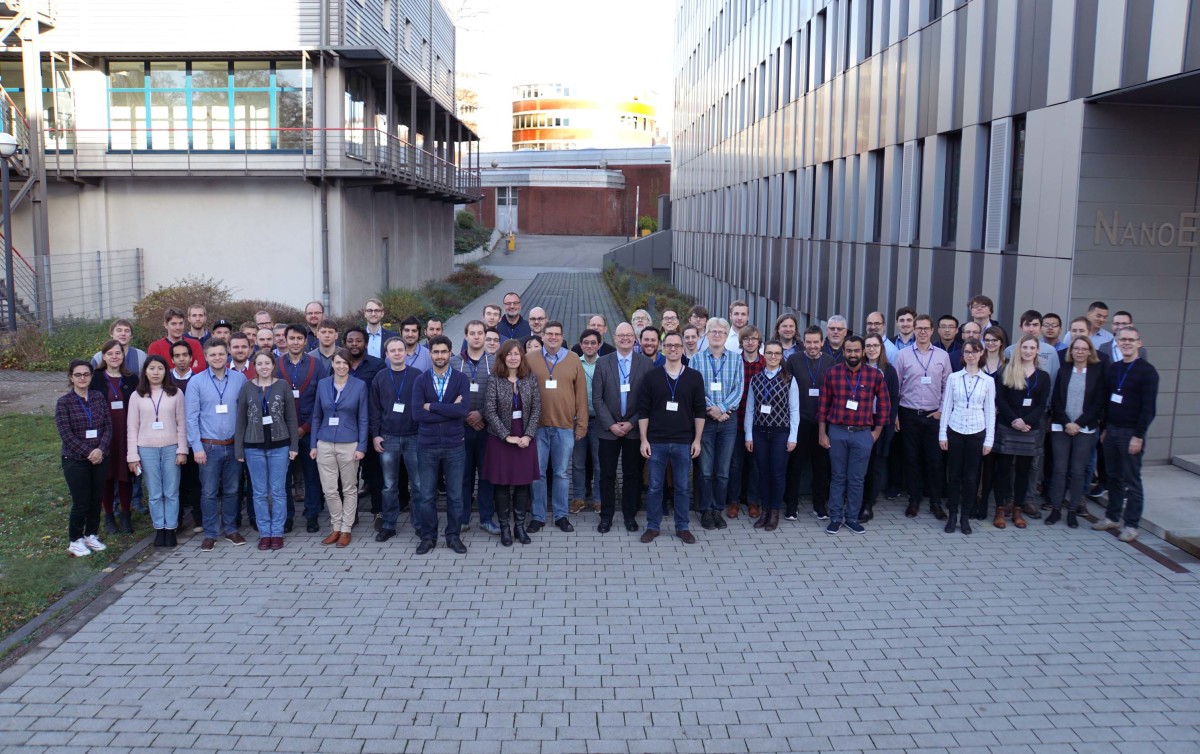
04./05.12.2018Successful kick-off meeting in Duisburg
74 scientists, including project leaders, but also young researchers, participated in our kick-off meeting in Duisburg on 4th/5th of December 2018.
> more about: Press release CENIDE, 17.12.2018
21.11.2018Aspire Afternoon: Equal Opportunities in Scientific Research
The CRC 1093 and CRC/TRR 247 invite you to participate in our joint Aspire Afternoon on 21.11.2018 from 2 to 5 pm.
Prof. Tomas Brage, Lund University, will give a plenary lecture about "What does Gender have to do with Science?".
Dr. Jonathan Müller, Birmingham University, and Prof. Candace Chan, Arizona State University, will give insights into the career and research systems in Great Britain and the USA, respectively.
Guests are welcome!
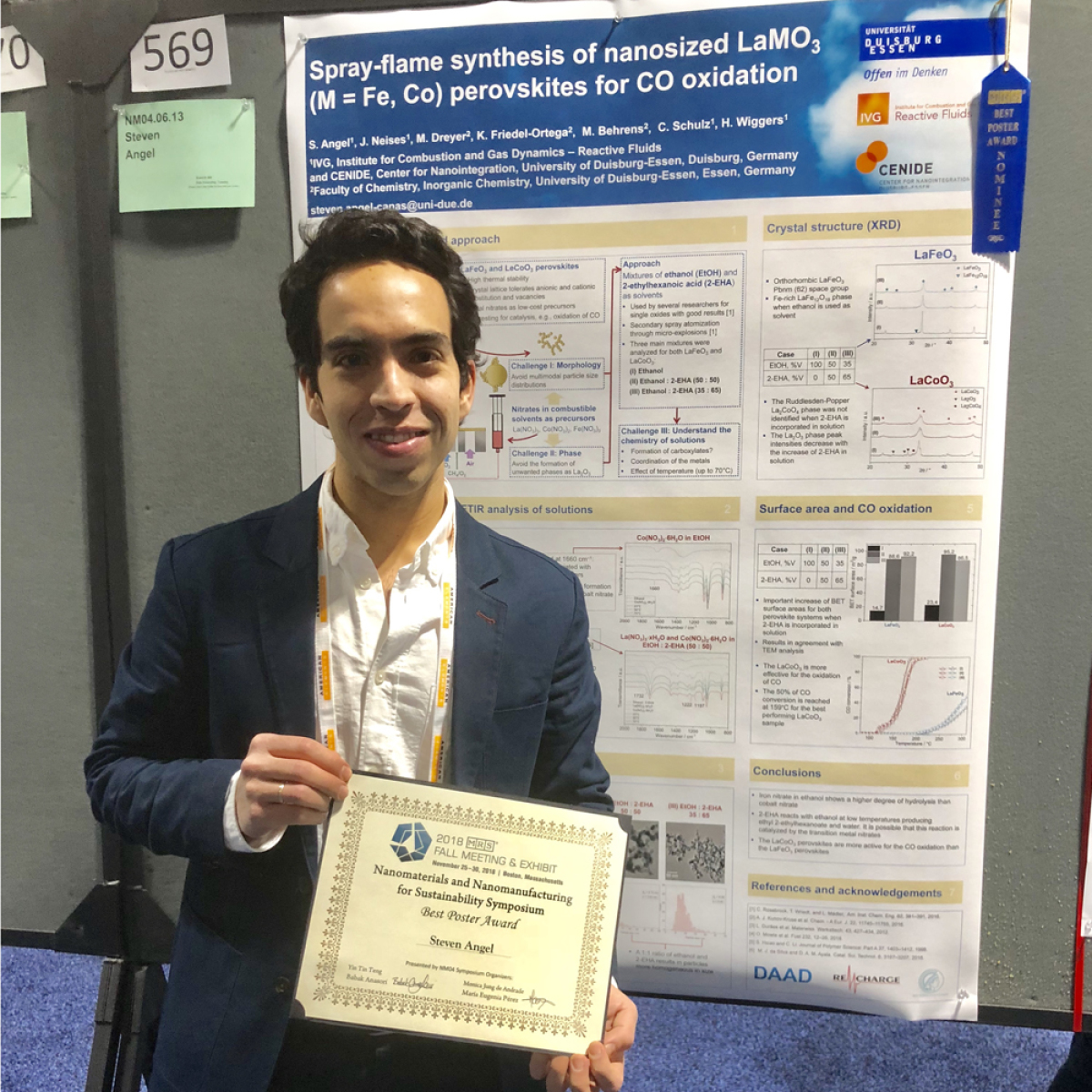
Materials Research SocietyBest Poster Award for Steven Angel
Steven Angel, PhD candidate in project C2, received the Best Poster Award at the "Nanomaterials and Nanomanufacturing for Sustainability Symposium" at the Materials Research Society conference in Boston in November 2018.
His poster entitled „Spray-flame synthesis of nanosized LaMO3 (M = Fe, Co) perovskites for CO oxidation” is presenting results of his work with two solvents (Ethanol and 2-Ethylhexanoic acid) and their influence on spray-flame synthesis of the perovskites LaFeO3 and LaCoO3.
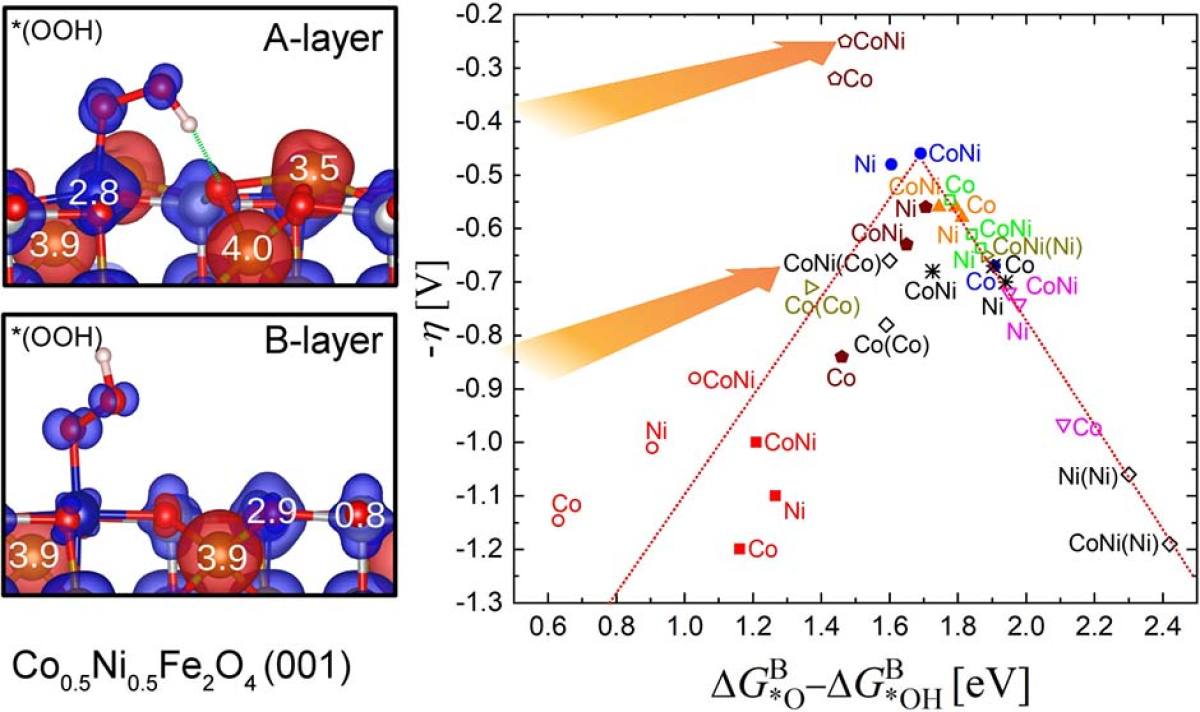
Publication alertSurface Termination and Composition Control of Activity of the CoxNi1−xFe2O4(001) Surface for Water Oxidation: Insights from DFT+U Calculations
Using density functional theory calculations with an on-site Hubbard term (DFT+U), we explore the effect of surface termination and cation substitution on the performance of the CoxNi1–xFe2O4(001) surface (x = 0.0, 0.5, 1.0) as an anode material in the oxygen evolution reaction (OER). Different reaction sites (Fe, Co, Ni, and an oxygen vacancy) were investigated at three terminations: the B-layer with octahedrally coordinated Co/Ni and with an additional half and full monolayer of Fe (0.5A and A-layer, respectively). Ni substitution with an equal concentration of Co and Ni (x = 0.5) reduces the overpotential over the end members for the majority of reaction sites. Surface Co cations are identified as the active sites and the ones at the A-layer termination for x = 0.5 exhibit one of the lowest theoretically reported overpotentials of 0.26 V. The effect of the additional iron layer on the active site modification is 2-fold: analysis of the electronic properties and spin densities indicates that the additional Fe layer stabilizes a bulk-like oxidation state of +2 for Co and Ni at the A-layer termination, whereas at the B-layer termination, they are oxidized to 3+. Moreover, the unusual relaxation pattern enables the formation of a hydrogen bond of the OOH intermediate to a neighboring surface oxygen that lowers the reaction free energy of this formerly rate-limiting step, leading to a deviation from the scaling relationship and almost equidistant reaction free-energy steps of intermediates. This renders an example of how a selective surface modification can result in a significant improvement of OER performance.
Original publication
Hajiyani, H., Pentcheva, R.: Surface Termination and Composition Control of Activity of the CoxNi1–xFe2O4(001) Surface for Water Oxidation: Insights from DFT+U Calculations, ACS Catalysis 2018, 8 (12), 11773-11782.
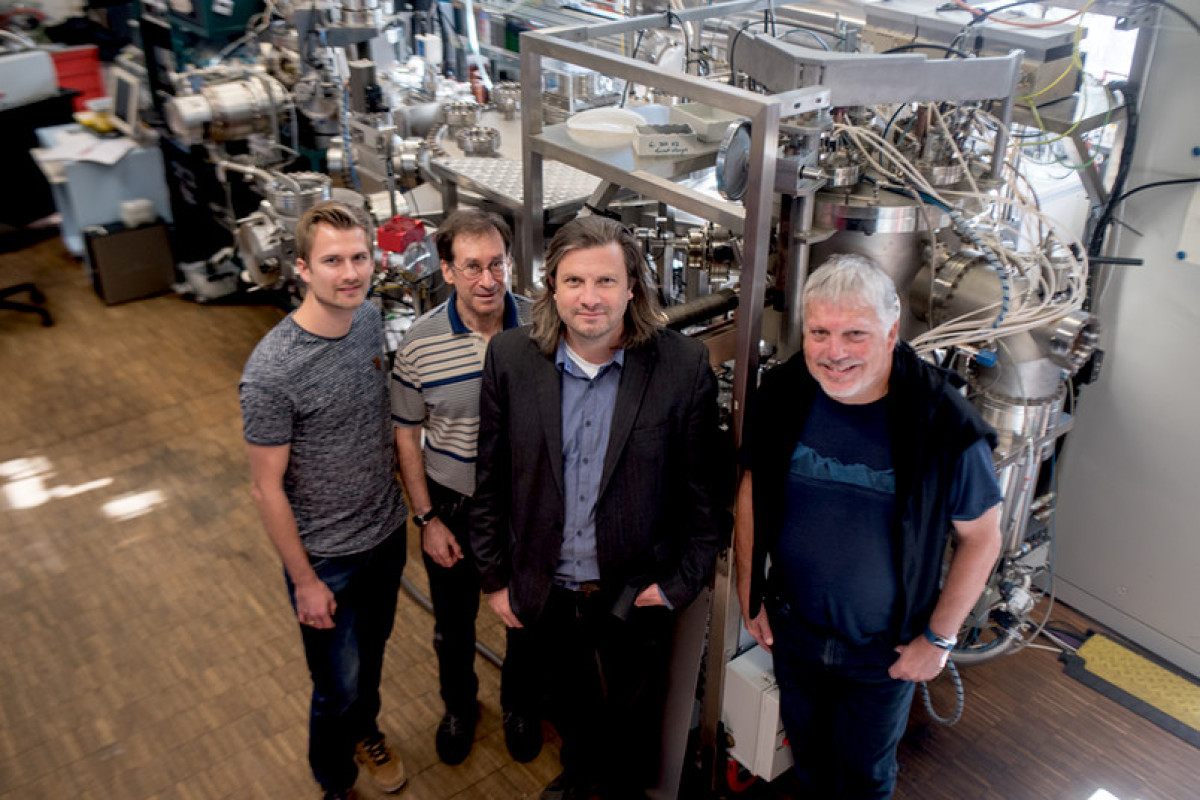
Publication alertDiscovery of a Multinary Noble Metal–Free Oxygen Reduction Catalyst
Scientists at Ruhr-University Bochum show that noble metal-free catalysts are as active as platinum and provide a base to produce more efficient and less expensive catalysts.
> more about: Press release Ruhr-University Bochum, 23.10.2018
Original publication
Löffler, T., Meyer, H., Savan, A., Wilde, P., Garzón Manjón, A., Chen, Y.-T., Ventosa, E., Scheu, C., Ludwig, A., Schuhmann, W.: Discovery of a multinary noble metal free oxygen reduction catalyst, Advanced Energy Materials 2018, DOI: 10.1002/aenm.201802269
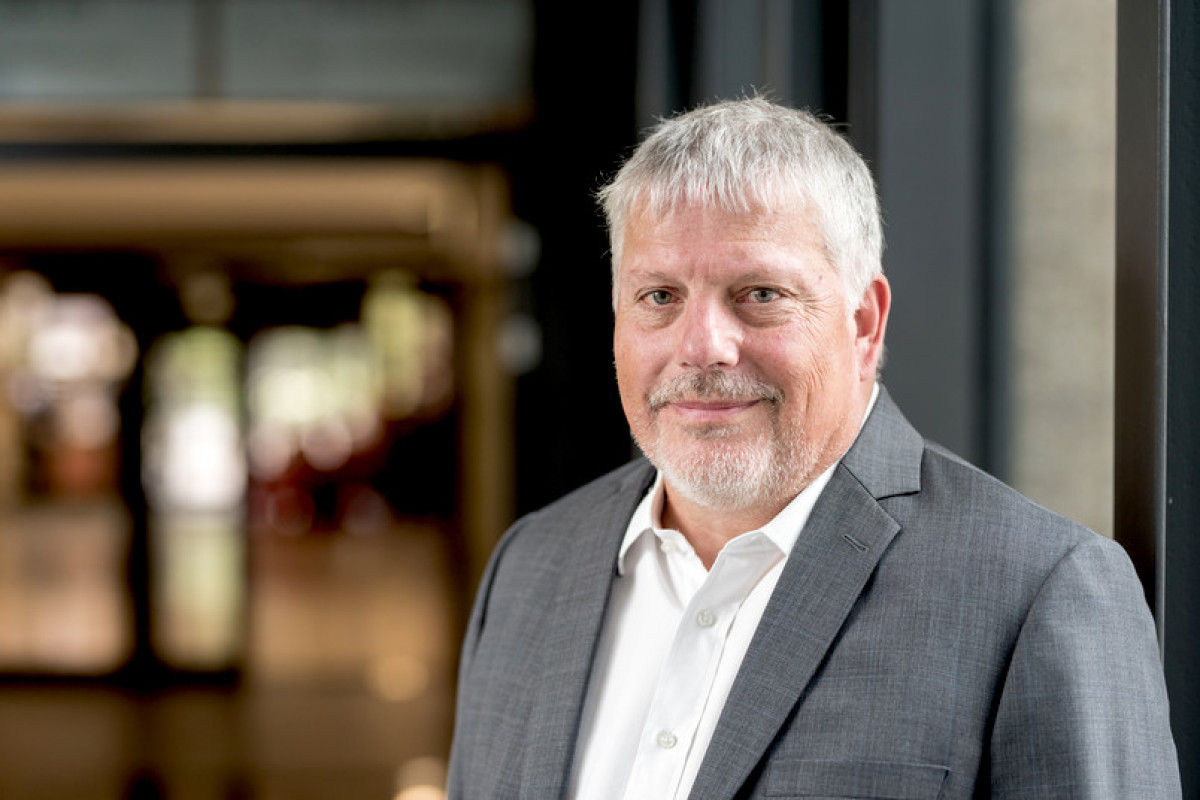
04.10.2018Prof. Dr. Wolfgang Schuhmann received Alessandro Volta Medal
The Electrochemical Society (ECS) honored the fundamental and applied research work of Prof. Dr. Wolfgang Schuhmann, Ruhr-University Bochum. He developed novel biosensors, redox polymers and materials for electrocatalysis and batteries. Congratulations!
> more about: Press release Ruhr-University Bochum, 05.10.2018
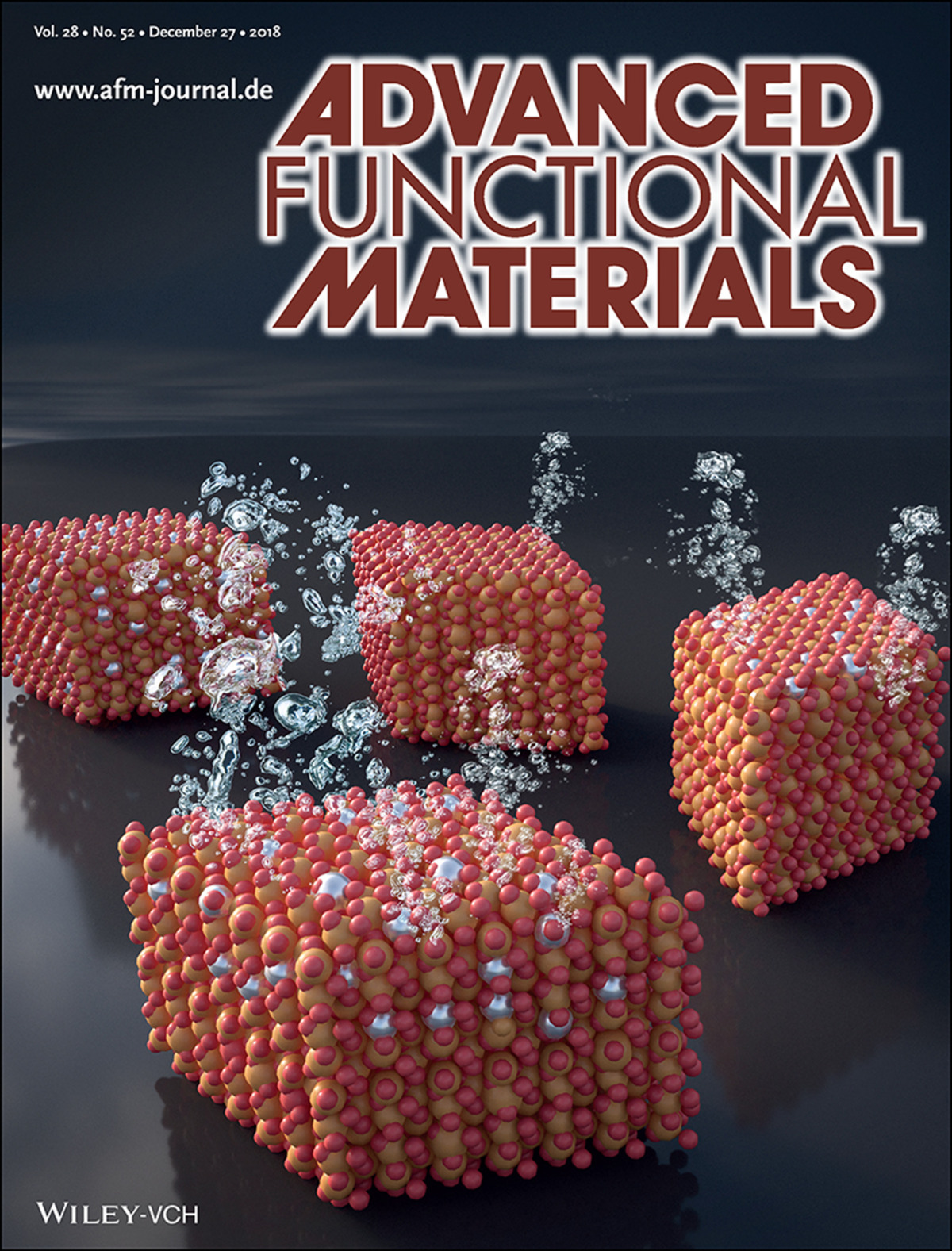
Publication alert: Cover PictureWhy Tin‐Doping Enhances the Efficiency of Hematite Photoanodes for Water Splitting—The Full Picture
The beneficial effects of Sn(IV) as a dopant in ultrathin hematite (α‐Fe2O3) photoanodes for water oxidation are examined. Different Sn concentration profiles are prepared by alternating atomic layer deposition of Fe2O3 and SnO x . Combined data from spectrophotometry and intensity‐modulated photocurrent spectroscopy yields the individual process efficiencies for light harvesting, charge separation, and charge transfer. The best performing photoanodes are Sn‐doped both on the surface and in the subsurface region and benefit from enhanced charge separation and transfer. Sn‐doping throughout the bulk of the hematite photoanode causes segregation at the grain boundaries and hence a lower overall efficiency. Fe2O3 (0001) and terminations, shown to be dominant by microstructural analysis, are investigated by density functional theory (DFT) calculations. The energetics of surface intermediates during the oxygen evolution reaction (OER) reveal that while Sn‐doping decreases the overpotential on the (0001) surface, the Fe2O3 orientation shows one of the lowest overpotentials reported for hematite so far. Electronic structure calculations demonstrate that Sn‐doping on the surface also enhances the charge transfer efficiency by elimination of surface hole trap states (passivation) and that subsurface Sn‐doping introduces a gradient of the band edges that reinforces the band bending at the semiconductor/electrolyte interface and thus boosts charge separation.
Original publication
Hufnagel, A.G., Hajiyani, H., Zhang, S., Li, T., Kasian, O., Gault, B., Breitbach, B., Bein, T., Fattakhova-Rohlfing, D., Scheu, C., Pentcheva, R.: Why Tin‐Doping Enhances the Efficiency of Hematite Photoanodes for Water Splitting—The Full Picture, Advanced Functional Materials 2018, 28 (52), 1804472.
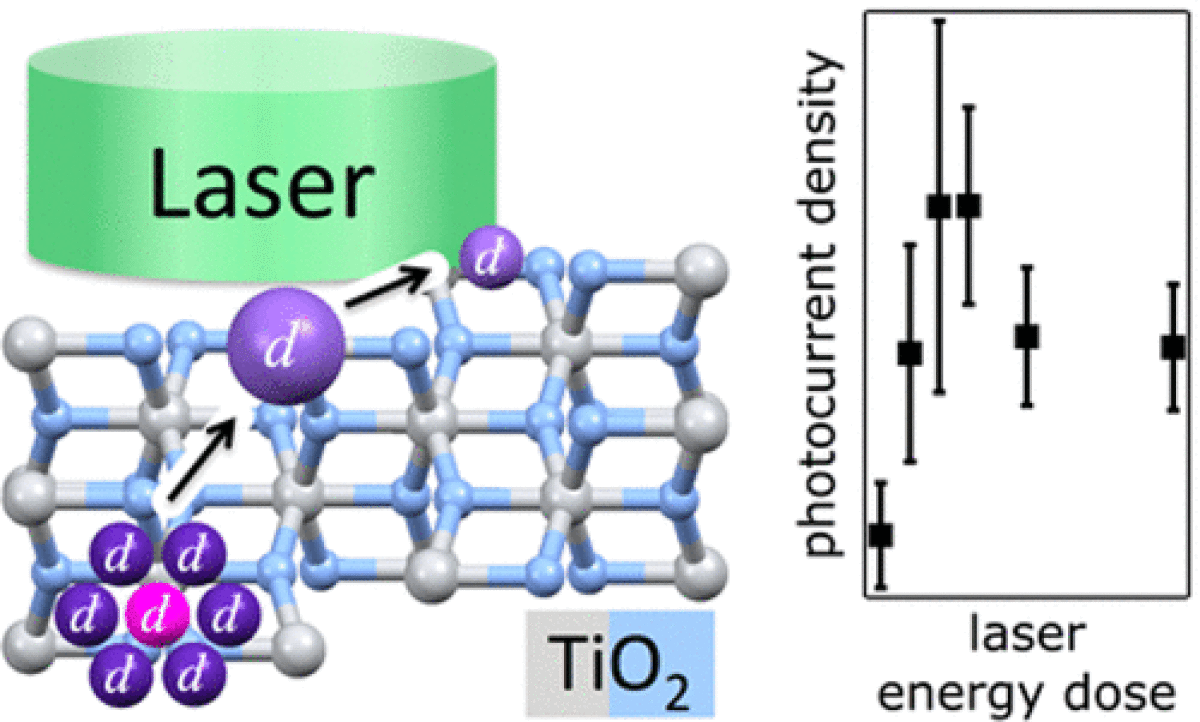
Publication alertMechanism of Laser-Induced Bulk and Surface Defect Generation in ZnO and TiO2 Nanoparticles: Effect on Photoelectrochemical Performance
Laser processing of neat and gold-nanoparticle-functionalized ZnO and TiO2 nanoparticles by nanosecond–355 nm or picosecond–532 nm light enabled control of photocurrent generation under simulated sunlight irradiation in neutral aqueous electrolytes. We obtained more than 2-fold enhanced photoelectrochemical performance of TiO2 nanoparticles upon irradiation by picosecond–532 nm pulses that healed defects. Laser processing and gold nanoparticle functionalization of ZnO and TiO2 nanomaterials resulted in color changes that did not originate from optical bandgaps or crystal structures. Two-dimensional photoluminescence data allowed us to differentiate and quantify surface and bulk defects that play a critical yet oft-underappreciated role for photoelectrochemical performance as sites for detrimental carrier recombination. We developed a detailed mechanistic model of how surface and bulk defects were generated as a function of laser processing parameters and obtained key insights on how these defects affected photocurrent production. The controlled healing of defects by pulsed-laser processing may be useful in the design of solar fuels materials.
Original publication
Lau, M., Reichenberger, S., Haxhiaj, I., Barcikowski, S., Müller, A.M.: Mechanism of Laser-Induced Bulk and Surface Defect Generation in ZnO and TiO2 Nanoparticles: Effect on Photoelectrochemical Performance, ACS Applied Energy Materials 2018, 1 (10), 5366-5385.
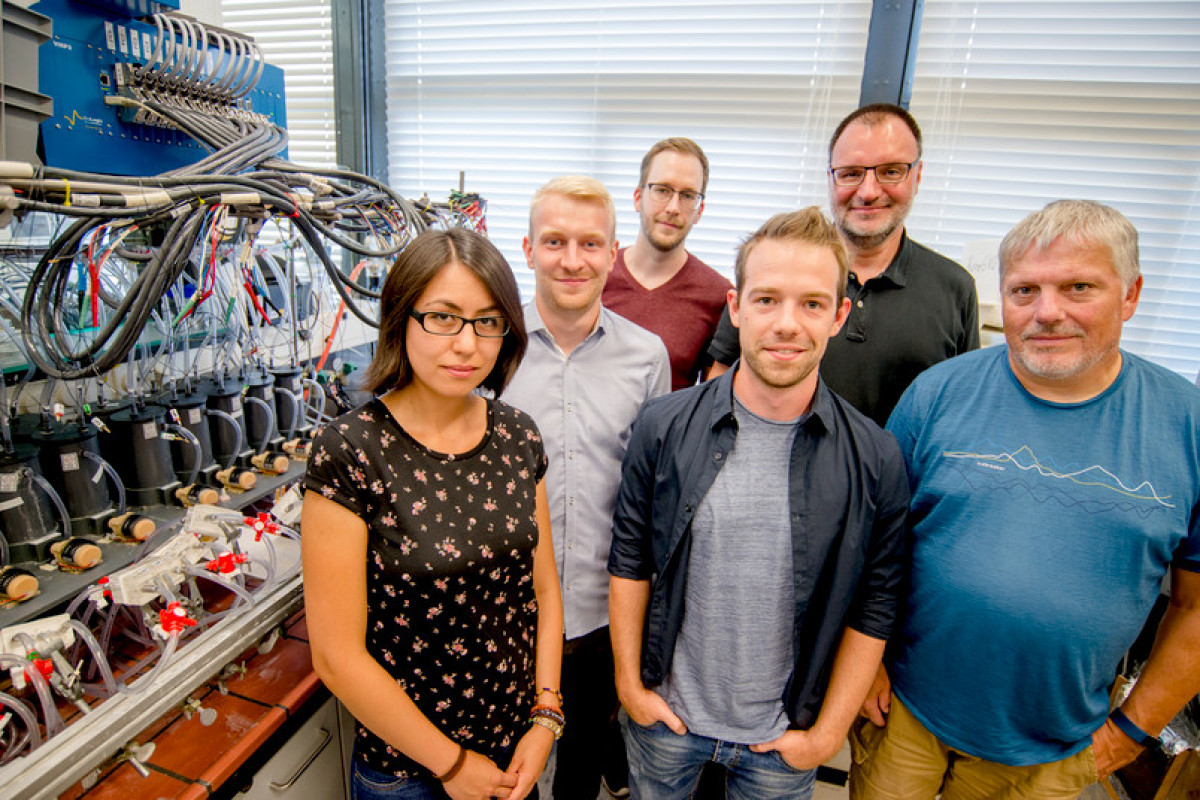
Publication alertNew catalyst with dual function
Scientists at Ruhr-University Bochum developed a new economical catalysts for a more sustainable plastics production.
> more about: Press release Ruhr-University Bochum, 24.07.2018
Original publication
Barwe, S., Weidner, J., Cychy, S., Morales, D.M., Dieckhöfer, S., Hiltrop, D., Masa, J., Muhler, M., Schuhmann, W.: Electrocatalytic 5-(hydroxymethyl)furfural oxidation using high surface area nickel boride, Angewandte Chemie International Edition 2018, DOI: 10.1002/anie.201806298.
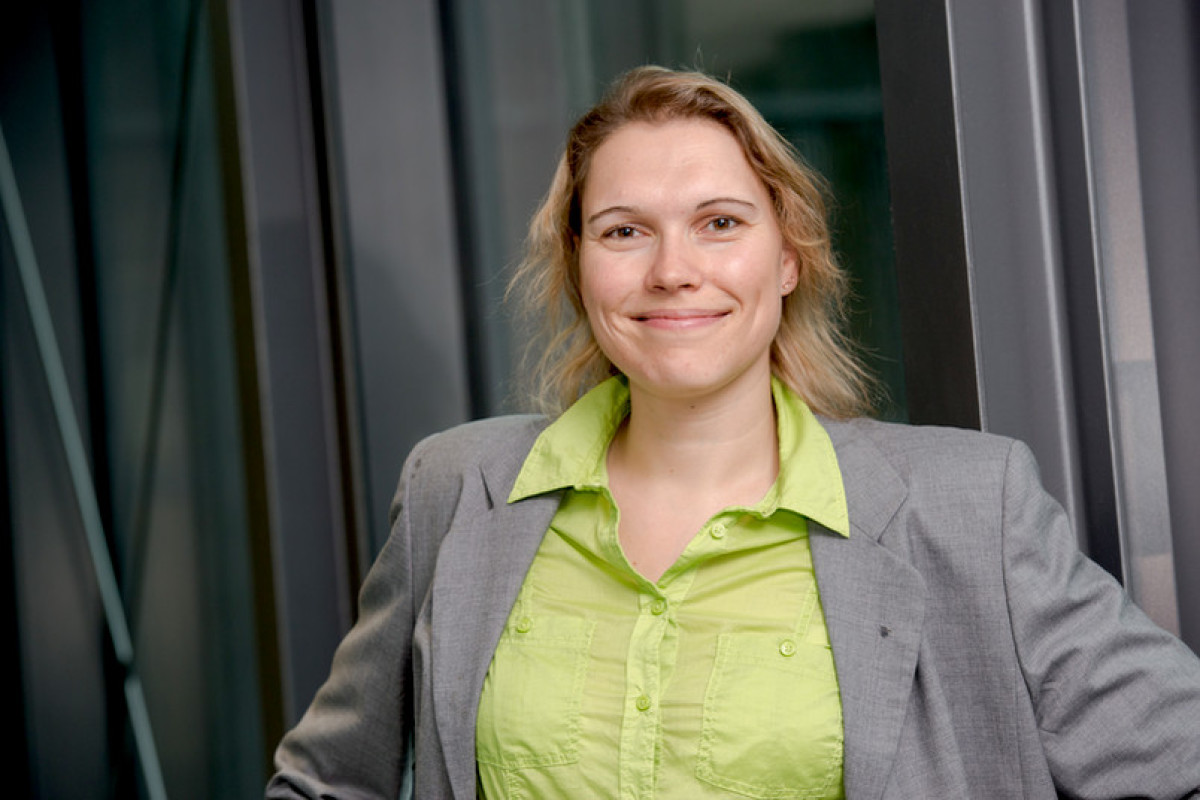
Hellmuth Fischer MedalProf. Dr. Kristina Tschulik honored for her research
DECHEMA awarded the Hellmuth Fischer Medal to Prof. Dr. Kristina Tschulik, Ruhr-University Bochum, for her fundamental research of electrochemical processes on nanoparticles.
> more about: Press release Ruhr-University Bochum, 15.06.2018
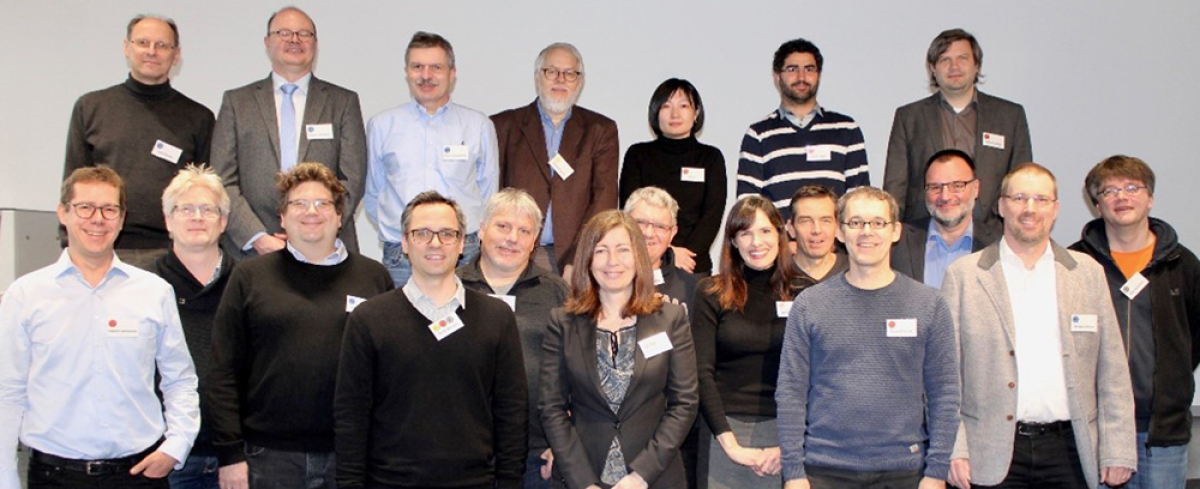
Heterogeneous Oxidation Catalysis in the Liquid PhaseNew Collaborative Research Centre / Transregio
The new research network, funded by the DFG (German Research Foundation), started its work in July 2018 and will combine catalysis research and nanotechnology. The University of Duisburg-Essen, the Ruhr University Bochum, the MPI für Kohlenforschung, the MPI CEC and the Fritz Haber Institute will work together to accumulate fundamental knowledge and "achieve great things together" (Prof. Dr. Malte Behrens, spokesperson of CRC/TRR 247).
> More detailed information can be found in the press releases:
Press release DFG, No. 17, 18.05.2018
Press release University of Duisburg-Essen, 18.05.2018
Press release Ruhr-University Bochum, 18.05.2018
Press release MPI CEC, 24.05.2018
Press release MPI für Kohlenforschung, 03.07.2018
Press release University of Duisburg-Essen, 28.03.2017


